Folks , this connection is almost mesmerising...Jambudwipa of the Vedas , Hyperborea of the Greek legends and the Hollow Earth civilisation as described by Olaf Jansen - it all seems to converge into a civilisation of EXTREME antiquity in the high Arctic . Like they say it's so far back in prehistory that even time itself seems to have forgotten...
https://www.ringingcedarsofrussia.org/ringing-cedars/pendants-amulets.html
In search of the Vedruss civilization.
The inexplicable similarity of Sanskrit and Russian.
The Vedruss civilization, which Anastasia discusses, sank into oblivion in the distant past. It disappeared so long ago that finding traces of its existence is a complicated matter.
Because of numerous wars, revolutions, and mass movements of ancient peoples, there remain for us no literary sources regarding the existence
of this civilization. But folklore and tales have remained, which transmit ancient histories and traditions in allegorical form. The language also remains. It is the language we shall talk about in this article.
As early as the 19th century, linguists noticed the connection between Sanskrit and the European languages, especially the Slavic languages.
For many centuries, Sanskrit was the official language in India, just as Latin was in Europe. Sanskrit is used as the
language of the liturgy, the holy texts - the Vedas. All the mantras that are repeated during yoga exercises are spoken in Sanskrit. As noted by linguists who are familiar with Sanskrit, this language is an ideal, perfect language, capable of expressing any shades of meaning, even the most subtle. For this reason it is called the language of consciousness, or the language of Nature. This most ancient language - today dead - is considered to be the father of all languages of the Indo-European group.
In all European languages are found a great number of words having the same root, but the common ground ends there. But in the Slavic languages, in addition to the coincidence of 60% of word roots, the very structures of the languages, which change the least
over time, are identical.
In 1963, Durga Prasad Shastri, an Indian professor of Sanskritology, arrived in Moscow. After several days, he declined to use an interpreter, since the people around him, he claimed,
were speaking some form of ancient Sanskrit, and he understood them.
From the lecture "Link Between Russian and Sanskrit" given on Feb 22 1964 in Moscow by Prof. Durga Prasad Shastri at the Indo-Soviet Cultural Society:
** "If I were asked what two languages of the world
resembled each other most, I would reply without hesitation: 'Russian and Sanskrit.'...**
When I went to Moscow, the Manager of my hotel game me the key for Room No. 234 and said: 'Dwesti tridtsat chetire'. For a moment I could not understand whether I was standing before a pretty girl in Moscow or I was in Banaras or Ujjain of our classical period of some 2,000 years ago. In Sanskrit 234 is 'Dwishat tridasha chatwar.'
When I was visiting village Kachalovo, 25 km from Moscow I met there a lady in her fifties. She introduced me to her son and daughter-in-law: "On moy seen i ona moya snokha" [Hi is my son and she is my daughter-in-law].
How I wished that Panini, the great Indian grammarian who lived some 2,800 years ago, could listen to the language of his own times so wonderfully preserved with the least possible variations in this part of the world.
** The Russian word "seen'[syn] is 'son' in English, and 'soonu' in Sankskrit. Also, 'madiy' of Sanskrit may be compared with 'moy' of Russian and 'my' of English. But it is only Russian and Sanskrit in which the possessive pronoun 'moy' and 'madiy' must be changed to 'moya'
and 'madiya' because it qualifies the word 'snokha' [daughter-in-law] which is feminine. The Russian word 'snokha' is 'snukha' in Sanskrit and
can be pronounced either way. Here the relationship goes beyond the son
on to the wife of the son too by similar words in both languages."**
Here is another Russian sentence; 'To vash dom, etot nash dom'. [That is your house, this is our house] In Sanskrit it is: 'tat vas dham, etat nas dham.'
The young languages of the Indo-European group, such as English, French, German, and even Hindi, which directly goes back to Sanskrit, must use the verb 'is,' without which the sentences given above cannot exist in any one of these languages. Only Russian and Sanskrit can manage without the link verb 'is,' while remaining completely correct, both grammatically and idiomatically.
The word 'is' is also very similar in both, 'est' in Russian and 'asti' in Sanskrit and yet another 'estestvo' in Russian and 'Astitva' in Sanskrit meaning 'existence' in both..."
** Further comparative studies of the two languages
revealed common laws for the transformation of pronouns into adverbs, of verbal nouns, similar rules for the declension of nouns and the conjugation of verbs, changes of adjectives according to gender and number, etc. Both languages use both prefixes and suffixes in an equivalent manner, prefixes and suffixes that impart to the newly formed
words not only a close, but almost identical meaning (not to mention a significant similarity in sound).**
But several scholars have gone further. The Indian historian B. G. Tilak analyzed the hymns of the Rig Veda and offered his conclusions in the work The Arctic Home in the Vedas, which was first published in 1903. In this book, Tilak translates and analyzes the hymns of the Rig Veda, which contain a number of indications that their authors were familiar with the natural realities of the Arctic, which were accurately and systematically reflected in the
prayers addressed to those gods to whom were attributed the role of manifestations of atmospheric forces and terrestrial phenomena. Moreover, Tilak revealed in the hymns the path of the increase in the duration of the "sun months" corresponding to the movement of the ancient inhabitants of the polar region from north to south. He also suggests that those persons who brought the Vedas to India had blue eyes
and light hair. And his most important conclusion is admittedly the suggestion that the distant ancestors of all Indo-Europeans underwent their initial formation in the last interglacial period, which lasted from 100,000 to 35,000 years BCE. The beginning of the last ice age displaced the people to the south, to the mainland, where their further dispersal began.
God Shiva (or Rudra in Rig Veda) is often depicted as blond man with blue eyes and pale skin.
Tilak was able to understand and decipher the contents of the priestly texts of all Vedic literature with such thoroughness, perhaps, by virtue of the fact that he was born and grew up in a family of Brahmins, and from his childhood heard the Brahmins' performances in song and their explanations of the hymns. His further education broadened his knowledge of the Vedas, and in addition helped him penetrate the secret meaning of their many allegories and metaphors,
penetrate the conventional secret language of magical appeals to the gods, a language beyond the comprehension of Western investigators.
In the 20th century, representatives of all sciences involving the distant past (paleoclimatology, geology, oceanology, glaciology, etc.) confirmed that, until the last glaciation,
a warm climate prevailed in the areas of the high northern latitudes. The dry land that once existed there was swallowed by the ocean after the melting of the glaciers, and in our northern seas only islands and extensive areas of shelves and shoals remain of it. On these most ancient lands, the human groups of our common distant ancestors once arose and developed.
![]()
![]()
![]()
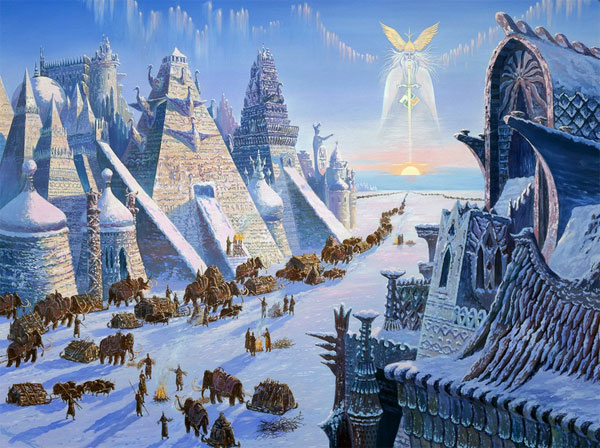
![]()
![]()
"Departure of the Hyperboreans" by Vsevolod Ivanov
It is possible that these northern people, who spoke a "Common Slavic" language, which subsequently became Sanskrit and
is preserved as a living language in the Slavic languages, could have been the Vedrusses themselves, and that it is in the Arctic where traces
of their vital activities must be sought.
Copyright: http://www.krivandino.ru/
Translation Copyright http://www.ringingcedarsofrussia.org/
Images Copyright: http://clubs.ya.ru/

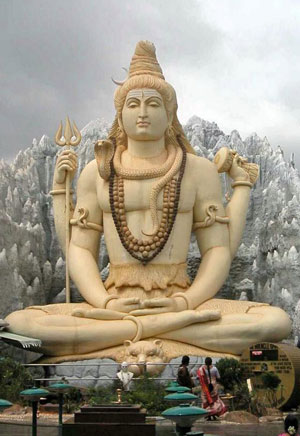
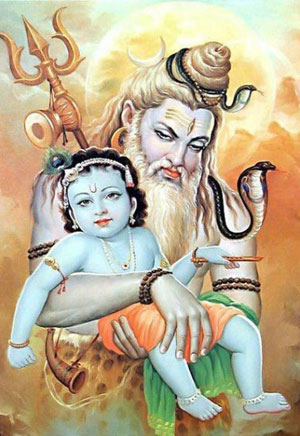
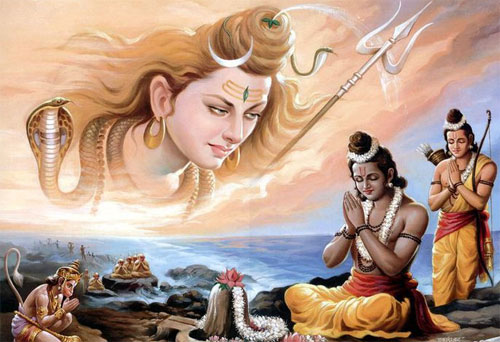
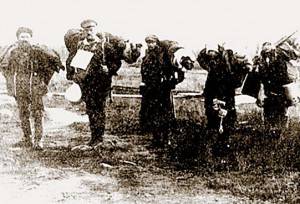 Numerous
Numerous